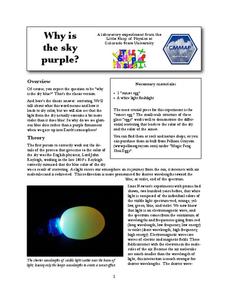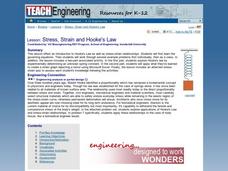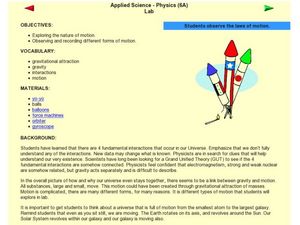Teach Engineering
Accelerometer: Centripetal Acceleration
Scholars build robotic arms that swing back and forth and use them to collect velocity and acceleration data. To analyze the results, pupils compare data to the equations for angular velocity and centripetal acceleration.
Colorado State University
Why Is the Sky Purple?
The color of the sky depends on the time of day. Young scholars experiment with scattering different wavelengths of light to recreate the color of the sky. They observe both the longer blue wavelengths and the shorter red and orange...
National Nanotechnology Infrastructure Network
Synthesis and Characterization of CdSe Quantum Dots
Does the size of a sample change the physical properties of that substance? It turns out it can! Young scientists combine physics and chemistry to synthesize CdSe quantum dots and record their color properties. Learners should...
American Museum of Natural History
Thinking in the Three Dimensions
Discover different dimensions with paper folding. Pupils first read about zero, one, two, and three dimensions, and then learn about the fourth dimension, time. They then use origami to create models of shapes in three dimensions and use...
American Institute of Physics
The Black Scientific Renaissance of the 1970s-90s: African American Scientists at Bell Laboratories
A two-part lesson asks young scientists to research the contributions of African American scientists at Bell Laboratories. After presenting their findings, class members watch two demonstrations that introduce them to total internal...
Curated OER
Archimedes' Principle of buoyancy
Young scholars use the internet to research Archimedes' principle of buoyancy. In groups, they summarize the principle and share it with the class. They also participate in experiments in which they test the principle and share their...
Curated OER
Levers and Pulleys
Seventeen pages of material leave you well-prepared to carry out this instructional activity on levers and pulleys. Photos and diagrams make the instructions clear; resource links provide additional information. The missing aspects of...
Curated OER
Stress, Strain and Hooke's Law
Students study Hooke's Law and stress-strain relationships. In this spring lesson students create a strain graph in Microsoft Excel.
Curated OER
Sometimes, solid + liquid = gas
Third graders experiment with common household liquids and solids. In this chemical reaction lesson, 3rd graders discuss phase changes and experiment to find other ways to create gases. They use water, vinegar, lemon juice, flour, baking...
Curated OER
Famous People - A Quiz on Definite and Indefinite Articles
This online, interactive worksheet helps English language learners practice identifying the correct article among four options. Feedback is immediate by clicking on the answer button following each questions. It includes 15 questions...
Key Curriculum Press
Lesson 10.2 Volume of Prisms and Cylinders
Tenth graders investigate volume in class and in the real world. They explore volume of cylinders and prisms as it relates to different subjects. Pupils also investigate how important volume is in different career field.
Curated OER
All Quiet on the Western Front: Quiz
Ten online questions are provided in this quiz on the book, All Quiet on the Western Front. While the questions are good and intended to check reading comprehension this site has quite a few unrelated ads.
Curated OER
Discovering Elements
A periodic table of elements displays the elements in groups ordered by when they were discovered. Click-by-click, new elements are added, resulting in an almost up-to-date chart. In order to reinforce the idea that symbols are used in...
Curated OER
The Elementary Particle Masses
For this elementary particle mass worksheet, students calculate the mass of elementary particles in kilograms and million electron Volts. Students solve 4 problems finding Top Quark mass, total quark mass of a proton and Strange Quark mass.
Curated OER
Electrical Appliances
Students explore electricity in daily life by examining everyday appliances. In this electrical current lesson, students identify the differences between watts, volts and amps and how they relate to the devices we depend upon. Students...
Curated OER
Understanding: Uncertainty
Students discuss the Heisenberg uncertainty principle and how it applies to the subatomic world. Working in groups, they design a model that would help others to understand the uncertainty principle. Written explanations are included...
Education World
Every Day Edit - Marie Curie
In this everyday editing worksheet, students correct grammatical mistakes in a short paragraph about Marie Curie. The errors range from punctuation, spelling, grammar, and capitalization.
Curated OER
Integrating Physics-Observing and Experimenting to Find Relationships
In this experimental relationship worksheet, students read about direct and indirect relationships between variables in experiments. They answer three questions about relationships between variables.
Curated OER
Max Planck Study Questions
In this online interactive history worksheet, students respond to 10 short answer and essay questions about the accomplishments of Max Plank. Students may check some of their answers on the interactive worksheet.
Curated OER
Motion Experiment
Young scholars experiment with the laws of motion. In this motion lesson, students explore Newton's Laws of Motion. Young scholars work in groups experimenting with different objects and observing different types of motion.
Curated OER
Theoretical Quantum Physics... For Kids!
Students explore quantum physics by participating in several class activities. In this space-time lesson, students discuss the concepts of time traveling and the anatomy of an atom. Students draw geometric figures and utilize string to...
Curated OER
The Founder of Electromagnetism
Students identify and study the founder of electromagnetism. In this magnetism lesson students complete several experiments including building a galvanometer.
Curated OER
Stonehenge: Solving Ancient Mysteries
Students explore archeologists and anthropologists and the tools and methods they use to gather and interpret scientific evidence. They research current archaeological excavations and contact the scientists working at these digs.
Curated OER
Discovering Ohm's Law
Students explore the relationship of resistance, voltage, and current in series and parallel circuits using a computer model of a circuit board. They discover Ohm's Law by constructing series circuits.

























